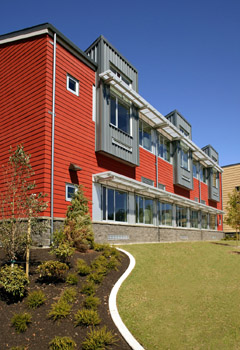|
Subscribe / Renew |
|
|
Contact Us |
|
| ► Subscribe to our Free Weekly Newsletter | |
| home | Welcome, sign in or click here to subscribe. | login |
Construction
| |
 |
September 22, 2005
Why process isn't a dirty word
AHBL

Kattermann
|
Collaborative permitting is an approach to the development-review process that can facilitate project approval.
In its ideal state it is a partnership of applicant and agency to achieve their respective and mutual goals. Stereotypical developers and agency staff may exist, but my experience indicates that the vast majority on both sides of the permit counter are genuinely interested in producing a quality project.
The challenge is that each owns different parts of the project — developers the "product" and agency staff the "process" — and most do not have an understanding or appreciation of the other.
Collaborative permitting should be considered for large, complex projects that may be fraught with obstacles that can cause significant delays and added costs. Collaboration is as much about process as outcomes. While most people don't like process, if it breaks down the project will have problems.

Photo by Art Grice Photography
The project team enlisted the help of Federal Way city staff and other agencies when a hearing delay threatened the schedule for Todd Beamer High School. The team credits the relationship it established with those agencies for its ability to resolve the problem quickly.
|
Believe it or not, many agency staff are not fond of process either, but they understand its purpose and how to make it work for or against a project, and we prefer to have them on our side. Also, agency staff has familiarity with local issues and politics that is invaluable in identifying potential obstacles. It is best to discover and address these issues sooner than later.
6 permitting characteristics
The Todd Beamer High School project for Federal Way Public Schools illustrates six characteristics of collaborative permitting.
In spring of 2000, the school district sought to obtain environmental and site plan approvals for a new high school scheduled to open in fall of 2003. In order to obtain state funding, the environmental process needed to be complete by early 2001.
The district established the climate at the outset. Rod Leland, from the school district, and program manager Jeff Greene of Greene-Gasaway Architects stressed the importance of maintaining a collaborative spirit with agency staff and others throughout the process. This spirit continued with Bassetti Architects, the project architects, who were selected after the environmental-review process started.
The 40-acre high school site was significantly constrained by wetlands associated with Hylebos Creek. Although the site is within the city of Federal Way, fire and utility approvals were required from two separate special districts. Sewer extension, which was not initially supported by the city or the utility district, required the approval of the King County Boundary Review Board.
Find mutual goals
The first collaborative permitting characteristic is identifying and understanding the distinct and mutual goals of the project team.
The project team consisted of the applicant's consultants and agency staff involved in review and approval (decision-makers). The school district's goals included funding, adherence to schedule and educational program needs for the site. The city's goals included avoiding or mitigating impacts to critical areas and addressing neighborhood concerns.
Our team involved city staff and a local environmental group in an early site visit to discuss these concerns. That same group participated in an open house to share information with the public and to listen to their concerns.
Who's in charge?
The second characteristic is to identify individual and group roles, responsibilities and authority.
Early in the process, key members of the project team held meetings to clarify who had the authority to address specific matters. Time lines were developed with agency staff. Critical dates and information were identified, along with the parties responsible for maintaining the schedule.
Open communication
Establishing clear lines of communication with regular contact is the third characteristic. Two challenges we faced were keeping the right people in the loop and overcoming the reluctance by some to report bad news.
It was vital to know about design changes or unfavorable comments before they became bigger issues, thus, everyone shared the goal of "no surprises." Communication was an ongoing challenge, but we kept the team informed through frequent phone calls and e-mails.
Ensuring follow-through
Consistent project management throughout the process is the fourth characteristic. We identified key individuals for the city and the district to ensure follow-through. Jim Harris, a senior planner with the city, and I were the key points of contact on the environmental and land use items.
If anything surfaced that could affect the schedule or the approval, Jim and I would follow up with our respective colleagues, even if the issue was outside our expertise. Our responsibility was to ensure the right people were communicating and addressing issues or providing information.
It's everyone's problem
That level of communication and follow-through resulted in the fifth characteristic, joint ownership of problems.
Because all had agreed to a schedule, all were invested in making it happen. When the schedule had to be changed, everyone understood the implications.
Find the solution
The final characteristic is a solution-oriented approach. This is the best indicator of a successful collaborative process because it reflects the level of ownership by the team.
One example of this was an 11th-hour issue that would have delayed the hearing on the sewer extension and thereby delay preliminary site work necessary to keep the project on schedule.
In order to ensure a hearing before the end of the year, we negotiated with the city, school district and water and sewer district on the specific language for a letter that had to be submitted to the Boundary Review Board just before the Thanksgiving holiday. This required virtually instant responses from team members that had to vet the wording through one or more people, in addition to some flexibility by board staff on the submittal deadline. The process could not have worked without the trust that had been built up to that point.
Although the applicant in this case was a school district, we apply the same approach to private development. The school project received at least the same level of public and agency scrutiny and was subject to the same standards as a private project. Time was money, literally, if state funding deadlines were missed.
The collaborative approach does not eliminate conflict, but it does create a better climate for finding solutions and obtaining permits on both public and private building projects.
Michael Kattermann is an associate principal of AHBL, where he works as a planning consultant for both public and private clients.
Other Stories:
- Softening the landing for college freshmen
- Small schools best prepared to teach the new '3 R's'
- Communities play larger role in shaping schools
- Schools districts discover the value of sustainability
- How to meet new state rules and provide real value
- Top concern of every school staff: air quality
- New schools teach lessons on technology design


